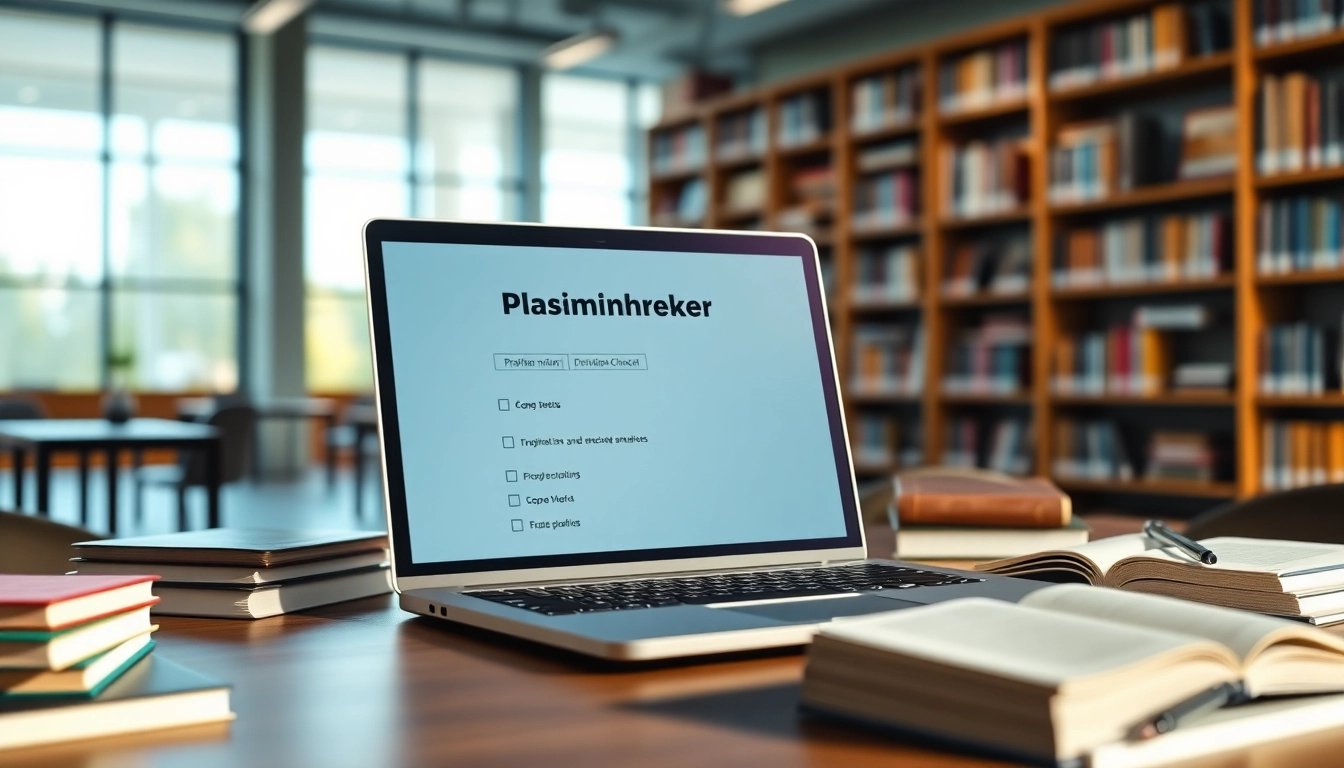Understanding Plagiarism and Why It Matters
In today’s digital age, where information is readily accessible and easily shared, the issue of plagiarism has garnered significant attention, especially within academic and professional settings. Plagiarism involves using someone else’s work or ideas without proper acknowledgment, consequently misrepresenting it as one’s own. This act not only undermines the integrity of scholarly work but also raises ethical concerns across various disciplines, including journalism, literature, and research.
To maintain academic integrity and ensure the authenticity of one’s work, employing a plagiarism checker becomes an invaluable tool. These technologies analyze texts and identify potential instances of unintentional or intentional plagiarism, assisting users in producing original content and adhering to ethical writing standards.
Defining Plagiarism in Academic Contexts
Plagiarism is predominantly defined and categorized within academic contexts as a serious offense. It can be classified into various types which include:
- Direct Plagiarism: This occurs when a writer copies text verbatim from a source without proper citation.
- Self-Plagiarism: Involves reusing one’s own previously published work without acknowledgment.
- Paraphrasing Plagiarism: This happens when someone rewrites someone else’s ideas without appropriate attribution, even if the words have been changed.
- Accidental Plagiarism: This can occur when a writer fails to cite sources correctly, often due to negligence or misunderstanding of citation rules.
The growing accessibility of online resources makes it easier for authors to cite information; however, it also increases the risk of plagiarism. Understanding these different forms of plagiarism is crucial for anyone involved in writing or research, as each type carries distinct implications for academic credibility.
The Consequences of Plagiarism
The consequences of plagiarism can be severe and manifold. For students, the repercussions typically range from failing grades to expulsion from their academic institutions. Educators and institutions uphold strict policies against plagiarism, reflecting its serious nature.
In professional settings, the stakes can be equally high. An author found guilty of plagiarism may face lawsuits, loss of reputation, and in some cases, career termination. For researchers, plagiarizing content can lead to retraction of published work, loss of funding, and diminished prospects for future research opportunities.
Types of Plagiarism Detected by Checkers
Plagiarism detection tools employ algorithms to identify various types of plagiarism, enhancing their effectiveness in detecting both common and sophisticated forms of content theft. Common detection tactics include:
- Text Matching: This occurs when the tool identifies strings of text that appear in other sources, highlighting direct plagiarism.
- Paraphrase Detection: Advanced algorithms evaluate the semantic meaning of sentences, helping to detect instances where ideas are borrowed without proper attribution.
- Source Comparison: Tools often compare submitted documents against vast databases of published works, web pages, and academic papers to find potential matches.
These detection techniques evolve continually, integrating new methodologies and technologies such as artificial intelligence to improve their accuracy and efficiency. Consequently, writers can trust these tools to spot various forms of plagiarism, allowing them to revise and produce original works.
How to Choose the Right Plagiarism Checker
With numerous plagiarism checkers available, selecting the most suitable one can be daunting. Various factors differentiate these tools, from user interface and accessibility to depth and accuracy of detection.
Comparing Features of Popular Plagiarism Checkers
When reviewing plagiarism checkers, consider the following features:
- Database Size: Tools with access to extensive databases typically offer more comprehensive checks against a larger body of work.
- Report Details: High-quality checkers generate detailed reports outlining matched sources and highlighting sections of the text flagged for similarity.
- User-Friendliness: The interface should be intuitive, allowing users to quickly upload documents and understand results.
- File Compatibility: A reliable checker should support multiple file formats to accommodate different types of submissions.
Popular examples that stand out include Grammarly, Quetext, and Turnitin, each possessing unique strengths; however, evaluating features critically can help identify which service aligns best with your specific needs.
Evaluating Accuracy and Reliability
Accuracy is a primary concern when selecting a plagiarism checker. Consider tools that have been independently evaluated through user satisfaction and accuracy tests. Reviews and comparisons posted by credible sources will provide insights into the effectiveness of specific tools.
Moreover, understanding the algorithms used can offer transparency. Some tools offer feedback about how they evaluate similarity—look for those that provide details and context in their results, thereby enabling informed revisions.
Cost-Effectiveness and Free Options
While many plagiarism checkers offer free basic services, the features available may be limited. Paid versions often encompass advanced features, such as deeper scans, more comprehensive databases, and additional tools for writing enhancement. Pricing structures can vary widely, with some platforms offering subscription-based models while others provide one-time purchase options.
When evaluating cost-effectiveness, assess whether features offered justify the price tag and consider whether free alternatives suffices for your needs—many students and casual writers may find that free versions adequately serve their requirements.
Best Practices for Using a Plagiarism Checker
Using a plagiarism checker effectively can aid in producing high-quality, original work. Implementing best practices can enhance your experience and lead to better outcomes.
Preparing Your Document for a Plagiarism Check
Before running a plagiarism check, ensure the document is polished and correctly formatted. Follow these steps:
- Finalize Content: Make sure the text is as complete as possible. A finalized document, free from typos and errors, allows for a more accurate scan.
- Check Formatting: Ensure proper headings, styles, and citations are consistent with the required format to provide clarity and context in the report.
Interpreting the Results from a Plagiarism Check
After running a plagiarism check, the results can be confusing if not interpreted correctly. Most tools will highlight sections of the text alongside links to original sources. Follow these steps:
- Review Matches: Examine highlighted sections closely and determine the level of similarity—determine whether direct quoting, common knowledge usage, or actual plagiarism has occurred.
- Evaluate Sources: Link to original sources can also clarify proper citation practices or offer direction for necessary revisions.
Revising Your Work Based on Feedback
Once potential plagiarism is detected, the next step is to revise the work based on the feedback received. Consider these actions:
- Proper Citation: Ensure any borrowed ideas are appropriately cited, adhering to the relevant citations style (APA, MLA, Harvard, etc.)
- Rephrasing: Consider rewriting sections that are too similar to the original sources—developing your own voice and style while maintaining the essence of the information often yields original content.
Integrating Plagiarism Checkers in the Writing Process
To maximize the advantages of plagiarism checkers, individuals should integrate their use throughout the writing process rather than reserving checks for the final draft.
Using Plagiarism Checkers During Drafting
Ensuring originality throughout the drafting process can significantly mitigate the risk of unintentional plagiarism. Running portions through a plagiarism checker can provide insights and alert writers to potential issues as they develop ideas and content.
Enhancing Collaboration with Plagiarism Tools
Collaborative projects can increase the risk of overlapping or unoriginal content. Utilizing plagiarism checkers as a group resource can promote accountability among team members and minimize overlap. Platforms that show review histories and adjustments can further optimize collaboration.
Educating Peers and Students on Plagiarism Tools
A vital aspect of fostering a culture of integrity in writing involves educating peers and students about the significance of plagiarism checkers. Institutions and writing centers can lead workshops, emphasizing crossing the line of borrowing to creating original content. Promoting familiarity with plagiarism tools encourages ethical writing practices, ensuring that writers understand the importance of originality.
Future Trends in Plagiarism Detection Technology
The field of plagiarism detection is evolving rapidly, influenced by advancements in artificial intelligence and machine learning. Staying informed about emerging trends can help individuals and institutions adopt practices that foster integrity.
The Role of AI in Evolving Plagiarism Checkers
Artificial intelligence plays a vital role in enhancing the accuracy and sophistication of plagiarism detectors. AI algorithms are becoming adept at recognizing nuanced forms of content duplication and paraphrasing, thus improving detection rates significantly. As AI technology continues to mature, we can anticipate even higher standards of accuracy in plagiarism detection.
Anticipating Changes in Academic Standards
As the landscape of higher education continues to transform, academic standards around originality and authorship will likewise evolve. Many institutions are adopting an increased emphasis on developing skills for academic writing and integrity, thus necessitating the continual adoption of plagiarism detection tools as a standard practice.
Innovative Features for Future Plagiarism Checkers
Future plagiarism checkers may widen their capabilities to include features such as built-in writing enhancements, AI-driven suggestions, and real-time feedback on citation practices. Innovations like blockchain technology for authorship verification may further bolster the efforts to combat plagiarism, paving the way for more secure and credible academic publishing.
In conclusion, plagiarism checkers serve as invaluable tools in upholding academic integrity across diverse fields. By understanding the nuances of plagiarism and effectively utilizing detection technologies, individuals can enhance their writing, cultivate originality, and contribute positively to the academic community.



